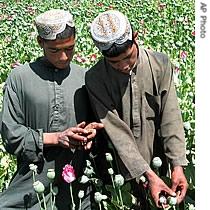-
(单词翻译:双击或拖选)
By Lisa Schlein
Geneva
04 September 2006
The Geneva-based International Organization for Migration1 says there is a connection between the illegal trade of drugs in Afghanistan and human trafficking. IOM is holding a three-day workshop in the Afghan capital, Kabul, to make government officials more aware of the problem and the need for them to take action.
------
The International Organization for Migration says given the scale of problems facing Afghanistan, human trafficking does not come out on top. But the organization notes that larger issues like the ongoing2 insurgency3, illegal drugs, and massive poverty help create the conditions in which human trafficking thrive.
 Young Afghan farmers gather poppies in their field in Zadi Dusht district of Kandahar, Afghanistan (File photo) |
||
The Head of IOM's Counter Trafficking Department, Richard Danziguer, tells VOA there is a link between various forms of organized crime, such as the illegal drug trade and human trafficking.
"When there is criminal activity, especially drug trafficking, weapon trafficking, often we will find there is a link to human trafficking as well," he said. "And, then some people actually are forced into working for the opium godfathers, if you will, working as practically slave labor6 in the fields cultivating the poppy."
According to the 2006 State Department Report on Trafficking in Persons, Afghanistan is a source country for women and children.
The IOM says children are trafficked within the country to work as beggars or as bonded7 labor in the brick kiln8 and carpet making industries. It says women and girls are kidnapped or sold for forced marriages. They are pushed into prostitution and sometimes used to settle debts or to resolve conflicts.
Internationally, IOM says Afghan women and girls are being trafficked primarily to Iran, Pakistan, and Saudi Arabia.
Danziguer says it is very difficult to get figures on how many people are trafficked because it is an illicit9 activity and few victims are identified or come forward.
"Any of the global figures you may have heard which range from 600,000 to several million-none of them are scientific figures and this is one of the issues, we along with other organizations, are constantly trying to get a handle on how we can get a better idea of what the scale of the problem is-first of all at the global level and, of course, the national levels as well," he said.
IOM says it will take years to tackle the root causes of human trafficking, such as poverty. But it notes there are measures governments can take to address the problem in the short term.
For example, it says government officials at all levels must be made aware of the problem and law enforcement officers must be taught how to identify trafficking and how to investigate cases. It says families must be educated about the potential dangers of going abroad for work and women must learn that they have human rights that must be respected.
 收听单词发音
收听单词发音
1
migration

|
|
| n.迁移,移居,(鸟类等的)迁徙 | |
参考例句: |
|
|
|
2
ongoing

|
|
| adj.进行中的,前进的 | |
参考例句: |
|
|
|
3
insurgency

|
|
| n.起义;暴动;叛变 | |
参考例句: |
|
|
|
4
opium

|
|
| n.鸦片;adj.鸦片的 | |
参考例句: |
|
|
|
5
cultivation

|
|
| n.耕作,培养,栽培(法),养成 | |
参考例句: |
|
|
|
6
labor

|
|
| n.劳动,努力,工作,劳工;分娩;vi.劳动,努力,苦干;vt.详细分析;麻烦 | |
参考例句: |
|
|
|
7
bonded

|
|
| n.有担保的,保税的,粘合的 | |
参考例句: |
|
|
|
8
kiln

|
|
| n.(砖、石灰等)窑,炉;v.烧窑 | |
参考例句: |
|
|
|
9
illicit

|
|
| adj.非法的,禁止的,不正当的 | |
参考例句: |
|
|
|















